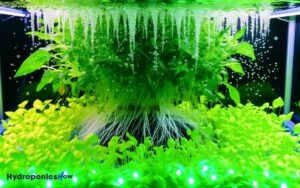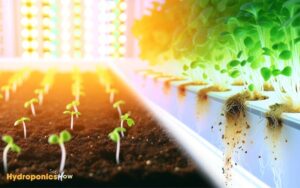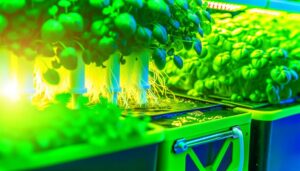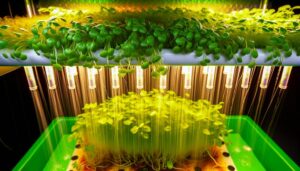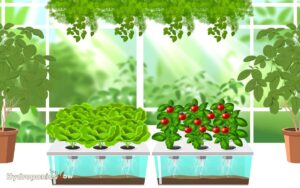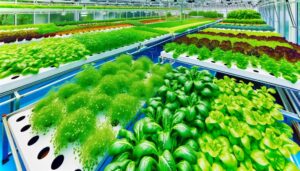Exploring How Miracle Gro Plant Food Is Used Hydroponically
Miracle-Gro Plant Food can be employed in hydroponic systems with meticulous attention to nutrient balance, solubility, and pH stability.
It contains essential macronutrients (nitrogen, phosphorus, potassium) and micronutrients (iron, manganese, zinc), which are essential for plant health.
Accurate mixing ratios, typically 1/4 teaspoon per gallon of water, are important for maintaining ideal nutrient concentrations.
Regular monitoring of Electrical Conductivity (EC) and pH levels prevents nutrient lockout and ensures balanced growth.
While not specifically formulated for hydroponics, with correct adjustments, Miracle-Gro can be effective. Continue for deeper insights into successful hydroponic integration.
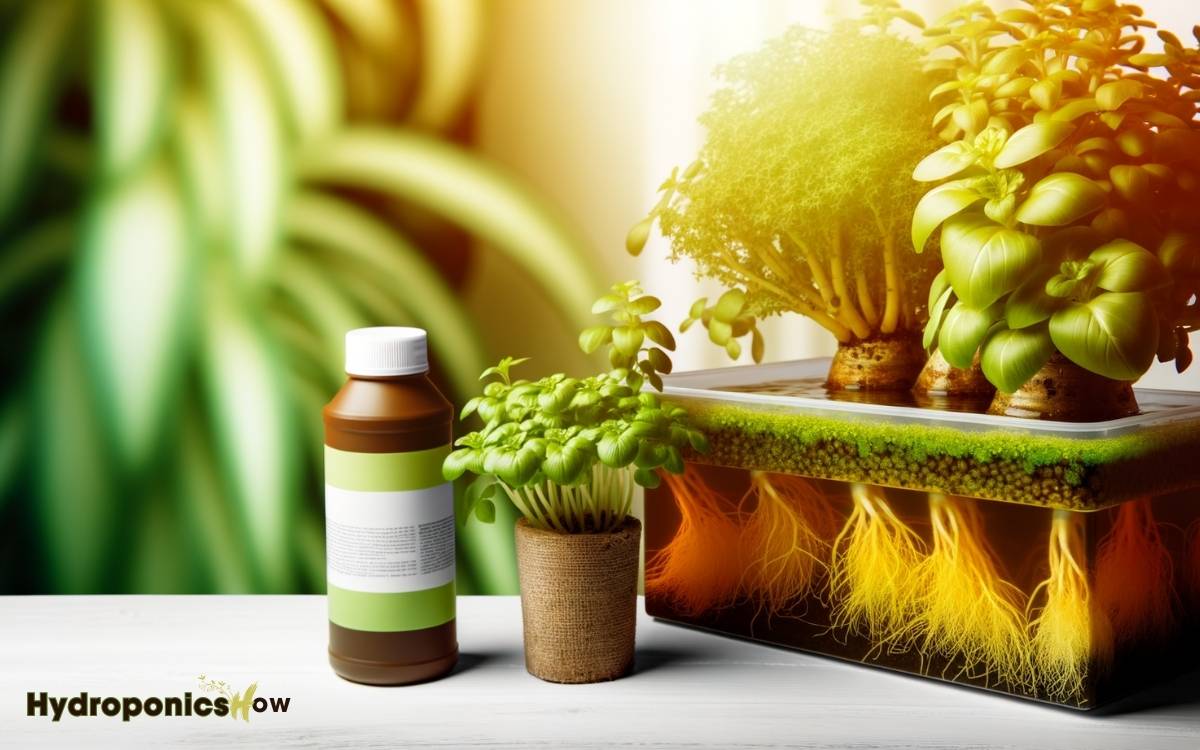
Key Takeaways
Understanding Hydroponics
Hydroponics is a method of growing plants without soil, utilizing nutrient-rich water solutions to deliver essential minerals directly to the plant roots.
This technique circumvents traditional soil-based agriculture, enabling precise control over the growing environment.
Key elements include macronutrients like nitrogen, phosphorus, and potassium, and micronutrients such as iron, manganese, and zinc, all dissolved in the water solution. This system promotes faster growth rates, higher yields, and efficient resource usage.
Hydroponic setups can vary from simple nutrient film techniques (NFT) to more complex aeroponic systems, each tailored to specific plants and growth conditions.
Understanding these dynamics is essential for optimizing plant health, ensuring that nutrient delivery is balanced, and preventing deficiencies or toxicities in the hydroponic environment.
Miracle-Gro Ingredients
Miracle-Gro plant food contains a balanced blend of essential nutrients, including macronutrients such as nitrogen, phosphorus, and potassium, and a suite of micronutrients like iron, manganese, and zinc, crucial for robust plant growth.
The formulation is engineered to meet the nutritional demands of various plant species, ensuring ideal development and yield.
Below is a breakdown of key ingredients:
| Nutrient | Function |
|---|---|
| Nitrogen (N) | Promotes foliage growth |
| Phosphorus (P) | Facilitates root development and flowering |
| Potassium (K) | Enhances overall plant health |
| Iron (Fe) | Essential for chlorophyll synthesis |
| Manganese (Mn) | Aids in photosynthesis and nitrogen metabolism |
This precise nutrient composition underscores Miracle-Gro’s efficacy in fostering lush, healthy plants.
Nutrient Requirements
Understanding the nutrient requirements of hydroponically grown plants necessitates an analysis of essential nutrients.
This includes macronutrients like nitrogen, phosphorus, and potassium, as well as micronutrients such as iron, manganese, and zinc.
Compatibility factors with Miracle-Gro Plant Food must be assessed to guarantee ideal nutrient uptake and balanced growth.
This involves evaluating the formulation’s solubility, pH stability, and ion availability in a hydroponic environment.
Essential Nutrients Breakdown
The effective use of hydroponic systems hinges on providing plants with a meticulously balanced spectrum of essential nutrients.
This includes macronutrients like nitrogen, phosphorus, and potassium, as well as trace micronutrients such as iron, manganese, and zinc.
Macronutrients support fundamental physiological processes. Nitrogen drives chlorophyll production, phosphorus is essential for energy transfer through ATP, and potassium facilitates enzyme activation and osmoregulation.
Micronutrients, though required in lesser quantities, are critical for specific biochemical functions. For example, iron is essential in electron transport, manganese in photosynthesis, and zinc in enzyme synthesis.
A deficiency or imbalance in any of these nutrients can lead to suboptimal plant growth, underscoring the necessity of an accurately formulated nutrient solution in hydroponic applications.
Hydroponic Compatibility Factors
Ensuring hydroponic compatibility requires a thorough understanding of the specific nutrient requirements and solubility profiles of the chosen plant food.
In hydroponic systems, essential nutrients must be readily available in precise concentrations to guarantee ideal plant growth.
Miracle Gro Plant Food, while formulated for soil, may not meet the stringent demands of a hydroponic environment.
Key factors to take into account include:
- Nutrient Balance: Ensuring the correct ratio of macronutrients (N-P-K) and micronutrients.
- Solubility: Evaluating how well the nutrients dissolve in water to prevent clogging and ensure uptake.
- pH Stability: Compatibility with the pH levels required for hydroponic solutions.
- Electrical Conductivity (EC): Monitoring to avoid nutrient lockout or deficiency.
- Purity: Examining for potential contaminants that could harm plant health or system efficiency.
Mixing Miracle-Gro
When mixing Miracle-Gro for hydroponic systems, precise adherence to proper mixing ratios is essential to maintain the best nutrient concentrations.
Begin by dissolving the recommended amount of Miracle-Gro in a specified volume of water to create a homogenous nutrient solution.
Ensuring accurate measurements and thorough mixing will facilitate balanced nutrient availability, promoting robust plant growth.
Proper Mixing Ratios
Achieving ideal nutrient balance in hydroponic systems using Miracle-Gro requires precise adherence to specific mixing ratios. Ensuring accurate concentration levels is pivotal for maximum plant growth and health.
- Measure accurately: Use a calibrated scale for precise nutrient measurement.
- Dilution rate: Typically, a 1/4 teaspoon of Miracle-Gro per gallon of water is recommended.
- Consistency: Maintain consistent nutrient solution ratios to avoid nutrient imbalances.
- Monitor EC and pH: Regularly check Electrical Conductivity (EC) and pH levels to ensure they remain within the best range.
- Adjustments: Be prepared to tweak ratios based on plant species, growth stage, and specific hydroponic system requirements.
Following these guidelines guarantees balanced nutrient delivery, promoting robust and healthy plant development in hydroponic environments.
Nutrient Solution Preparation
After understanding the proper mixing ratios, the next step involves preparing the nutrient solution by accurately combining Miracle-Gro with water in a controlled manner.
Begin by measuring the precise amount of Miracle-Gro required, ensuring adherence to the recommended hydroponic dilution ratio.
Utilize dechlorinated water to avoid potential chemical interactions that might impair nutrient availability. Introduce the Miracle-Gro gradually into the water while stirring continuously to ensure homogeneous dispersion.
Monitoring the pH and electrical conductivity (EC) of the solution is vital; adjust the pH to the ideal range of 5.5 to 6.5 using pH up or down solutions.
Employ a calibrated EC meter to verify nutrient concentration, ensuring it aligns with the specific requirements of the hydroponic system and plant type.
Ph Considerations
Maintaining an essential pH level is vital for maximizing nutrient absorption and overall plant health in hydroponic systems using Miracle Gro Plant Food.
Ideal pH levels facilitate optimal uptake of macro and micronutrients, preventing deficiencies and toxicities.
The target pH range for hydroponic solutions is typically between 5.5 and 6.5. Regular monitoring is essential to guarantee stability, as fluctuations can adversely affect plant growth.
To effectively manage pH levels, consider the following:
- pH Meters: Utilize precise instruments for real-time monitoring.
- Buffer Solutions: Use these to calibrate pH meters accurately.
- pH Adjusters: Employ pH up or down solutions to maintain desired levels.
- Consistent Testing: Test solutions daily to detect any deviations.
- Nutrient Interactions: Understand how different nutrients influence pH dynamics.
Potential Problems
In hydroponic systems utilizing Miracle Gro Plant Food, common issues can include nutrient imbalances, root diseases, and inadequate oxygenation.
The formulation of Miracle Gro is typically designed for soil-based applications, which can lead to disproportionate nutrient uptake in hydroponics. Elements like nitrogen, phosphorus, and potassium may not be present in the best ratios required for hydroponic plants.
Additionally, the high salt content can accumulate, causing osmotic stress and impairing root function. The lack of proper drainage and aeration in such systems may exacerbate root diseases like Pythium and Phytophthora.
Moreover, oxygenation is essential in hydroponics; insufficient levels can lead to hypoxic conditions, thereby stunting growth and promoting pathogenic activity.
These challenges necessitate careful monitoring and adjustments.
Success Stories
Despite the inherent challenges, numerous hydroponic gardeners have reported impressive results by meticulously adapting Miracle Gro Plant Food to their systems. Their experiences shed light on the potential of this widely available nutrient solution when used with precision and care.
Key success stories include:
- Enhanced Growth Rates: Documented instances of faster vegetative growth compared to conventional hydroponic nutrients.
- Cost Efficiency: Significant savings on nutrient costs without compromising plant health.
- Improved Yield: Reports of higher fruit and vegetable yields, particularly with leafy greens and tomatoes.
- User Adaptations: Innovative methods for diluting and supplementing Miracle Gro to meet hydroponic requirements.
- Sustainability: Utilization of Miracle Gro in closed-loop systems, minimizing waste and optimizing resource use.
These success stories underscore the adaptability and potential efficacy of Miracle Gro in hydroponic applications.
Alternative Solutions
Hydroponic enthusiasts seeking alternatives to Miracle Gro often explore specialized nutrient solutions designed explicitly for soilless cultivation, optimizing plant growth and health through targeted formulations.
These alternatives, such as General Hydroponics Flora Series or Advanced Nutrients, offer a balanced blend of macro and micronutrients, ensuring precise nutrient uptake.
They incorporate chelated minerals that enhance bioavailability and uptake efficiency, essential for hydroponic systems. Additionally, these solutions are typically pH-buffered, maintaining an ideal pH range for nutrient absorption.
Expert Recommendations
Renowned agronomists and hydroponic specialists frequently highlight the importance of selecting nutrient solutions tailored to the specific needs of soilless cultivation systems.
They argue that while Miracle Gro plant food can be adapted for hydroponic use, it may not provide an ideal nutrient profile for various plant species.
Experts recommend solutions specifically formulated for hydroponics to achieve balanced nutrient uptake and robust plant growth.
Key considerations include:
- Nutrient Composition: Guarantee a balanced ratio of nitrogen, phosphorus, and potassium.
- Micro and Macronutrients: Include essential trace elements such as magnesium, calcium, and iron.
- pH Stability: Maintain a steady pH level suitable for hydroponic systems.
- Solubility: Use fully water-soluble nutrients to prevent clogging.
- EC Levels: Monitor electrical conductivity to avoid nutrient imbalances.
These factors are crucial for optimal plant health and yield in hydroponic systems.
Conclusion
To sum up, while Miracle-Gro plant food can be adapted for hydroponic use, it requires meticulous attention to nutrient ratios, pH levels, and potential deficiencies.
Analogous to walking a tightrope, precision and balance are paramount to avoid nutrient imbalances and system failures.
Alternative hydroponic-specific solutions may offer a more straightforward approach, ensuring top-notch plant health and growth. These solutions are designed to provide plants with optimal nutrient balance while reducing the need for constant monitoring. When considering aquaponics vs hydroponics differences, it’s important to note that hydroponics relies solely on nutrient solutions, whereas aquaponics integrates fish waste as a natural fertilizer. This fundamental contrast impacts system maintenance, cost, and sustainability, making hydroponics a more controlled yet input-dependent method.
Expert recommendations emphasize the importance of tailored nutrient formulations designed specifically for hydroponic systems to achieve the best results.

